A Taste of New Products at DEMA 2017Contents of this Issue: Bahamas Aggressor, The Bahamas Cozumel and the Cenotes, Yucatan, Mexico Will the Sport of Scuba Diving Survive? Youíll Need More Than That to Get Me to Visit Misfortune Follows the Siren Fleet Regulator Servicing: Do It Every Two Years Wooden Hulls, Tumble Dryers and Single Engines A Taste of New Products at DEMA 2017 What a Fish Knows: The Inner Lives of our Underwater Cousins Plastic is Suffocating the Ocean Catastrophe at Cocos Island, Costa Rica Editorial Office: Ben Davison Publisher and Editor Undercurrent 3020 Bridgeway, Suite 102 Sausalito, CA 94965 from the January, 2018 issue of Undercurrent
Every year the diving industry gathers at a convention center to meet and greet and launch new initiatives and products. This past November, it was Orlando's turn to host the event. A newcomer to the event was amazed to see icons of the diving industry, such as Bruce Wienke, the man who wrote the algorithm for many popular dive computers, Richard Pyle, the deep diving ichthyologist, National Geographic Explorer in Residence Sylvia Earle, and others like them strolling the aisles. That's typical, but it's also an indication of how small and personable the diving industry is.
As usual, there were few revolutionary products on display in the main hall (these days it's "gentle evolution"). For example, Suunto displayed its EON Core computer, a recreational version of the original EON steel (with the same intuitive 3-button menu logic) suitable for less deep diving (to only 262 feet (80m) deep), housed in a reinforced composite case but with a similarly sized TFL color display. Its rechargeable battery is good for 20 to 40 hours and wirelessly connects to a smartphone. With the addition of a suitable Suunto tank POD to a regulator's first-stage, it can monitor up to 10 different gases with the right number of PODs. One can alter the display to suit personal taste by connecting with the Movescount app. Available in 17 different languages, it is expected to sell for $999 plus $440 for a POD. www.suunto.com
Users can save, review and share their dives and other activities via Garmin apps, and even receive texts. The stainless steel model should retail for $999. https://explore.garmin.com/en-US/descent New to the show, the manufacturer of the COSMIQ+ dive computer, Deep Blu, has created an affordable instrument that wirelessly connects to your smartphone after the dive so that you can effortlessly create digital dive logs and connect with a wider online dive community. It costs $299. https://shop.deepblu.com/products/cosmiq-plus The annual DEMA show is where optimistic smaller manufacturers display prototypes to gauge their acceptability. The Thalatoo MAOI is such a product, a computer prototype that a diver straps directly over her mask so that at depth she can read dive duration remaining, no-deco time, ascent-rate and safety stop time on a head-up display. We'll have to wait to see if it comes to market. www.thalatoo.com The Ratio Color-Coded Wireless Transmitter has an LED that indicates tank pressure by changing from green to yellow and red on the unit when fitted to a regulator first-stage high-pressure port. It might prove useful to diving instructors who could see at a glance the status of their trainees' air supplies. It is also available as a head-up display and has the option of an occluding cover for the tank unit for those divers who wish to be discreet about their remaining air supply. It works with the iDive and iX3M computers and adds $618 to their price. www.ratio-computers.com A Plethora of Must-Have Accessories As usual, scores of must-have accessories were on display. Several companies offered personal oxygen analyzers for nitrox divers. Maxtec offered a version for use with the BC's direct-feed hose. They displayed the iMax Dive Buddy, a discreet wireless data logger that works unattended while you dive and interfaces directly with a smartphone app, and you can even download your dive profile direct to your Facebook page. www.maxtecscuba.com
Underwater photography is ruling the diving world, and endless booths exhibited light sources and camera housings. The GoPro's little HD cameras have taken the dive community by storm, and every year the company produces an improved model. This year it was the GoPro Hero 6 Black, which automatically sends footage to a smartphone three-times faster than before. With 4k 60 fps and 1080p 240 fps video, it delivers twice the performance when compared with the previous model, the Hero 5 Black. Of course, there's a price hike. It costs around $500. In the past, GoPro has had the biggest and most impressive booth, but, a sign of cutbacks, it was left to the company Backscatter to tell the story. www.backscatter.com Though divers are obsessed with attaching these little cameras to themselves, they often come back with nothing but recordings of their exhaled bubbles. A novel device that might solve the problem is a camera mount that fits on the front of a diver's regulator, thus avoiding the bubbles while allowing the user to monitor the LCD screen and see what she's recording. The Reg-Mount costs $35 from www.regmount.com. Indigo industries demonstrated its new and novel BZ-Delta wing-style BCD, which has buckles that are activated magnetically but held shut mechanically. A built-in lighting system that features 2000 lumens of hands-free illumination at the front and colored lights at the back not only indicates a diver's position in the water, but the rear lights change color according to the status of his air-supply. Is this a technological advance that we can really do without? www.indigo-industries.com
The unique SWES Technology D-1001 dive light from Canada generates its power from seawater and requires no special maintenance. It has an energy cell with an anode and cathode with electric power generated by seawater as the electrolyte. This means that forgetting to recharge or replace batteries in a diver's flashlight, or running out of charge during a dive, might be a thing of the past -- for ocean diving at least. Price to be announced. www.swestechnology.com
Realizing that the diving market is aging, Scubapro has come up with a mask where the user can easily change the optical lenses at home, without returning the mask to a dealer or resorting to special tools. Sensibly Scubapro has made both negative and positive lenses available, bearing in mind that we older divers suffer from ever shortening arms! The Zoom EVO basic mask costs about $68. www.scubapro.com A small British company is leading the way in conservation with a range of beachwear made from recovered and recycled ghost fishing nets and the Fourth Element Thermocline wetsuit, now made entirely neoprene-free and machine-washable. www.fourthelement.com. The company is aiming to eliminate plastic packaging of its products entirely by 2020. Looking for New Markets and Meeting Old Friends The dive industry is flagging. Open water dive certifications have been declining in the U.S. during the past decade, and the industry's various marketing techniques have not reversed the trend.†That, and expanding online sales have caused hundreds of dive stores to close.† At this year's DEMA show, CEO Tom Ingram discussed DEMA's social media marketing strategy.†Recognizing that minority participation in the sport is minuscule while America's minority middle class is growing wealthier, DEMA's well-conceived marketing pieces featured plenty of people of color. It was heartening to see the joys of diving presented to the full range of ethnically diverse Americans. DEMA show attendance is limited to by dive professionals, and as such, is less frenetic than consumer shows. It allows dive shops organizing group dive trips to compare what different dive operators worldwide have to offer. There are also well-attended seminars, and it's a great opportunity for divers to catch up with old friends from around the world. |

I want to get all the stories! Tell me how I can become an Undercurrent Online Member and get online access to all the articles of Undercurrent as well as thousands of first hand reports on dive operations world-wide
| Home | Online Members Area | My Account |
Login
|
Join
|
| Travel Index |
Dive Resort & Liveaboard Reviews
|
Featured Reports
|
Recent
Issues
|
Back Issues
|
|
Dive Gear
Index
|
Health/Safety Index
|
Environment & Misc.
Index
|
Seasonal Planner
|
Blogs
|
Free Articles
|
Book Picks
|
News
|
|
Special Offers
|
RSS
|
FAQ
|
About Us
|
Contact Us
|
Links
|
3020 Bridgeway, Ste 102, Sausalito, Ca 94965
All rights reserved.

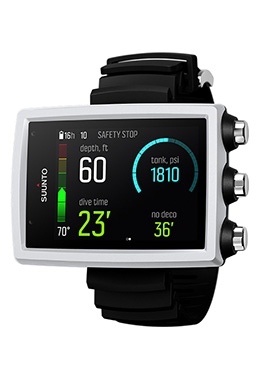 Evolution in Diving Computers
Evolution in Diving Computers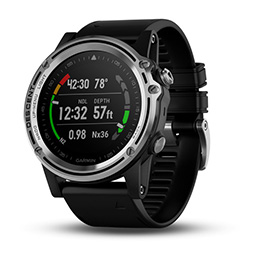 More notable is that
navigation giant Garmin
has entered the diving
computer arena with the
Garmin Descent Mk1,
a good-looking oversized-
watch platform for
a multi-sport diver who
wants one instrument
to guide him through
life. Besides the diving
computer functions for
recreational, technical (multi-gas) and free diving,
it employs a 3-axis compass, a surface GPS, a heart rate monitor, and full-color map displays. It offers
sports/training, fitness, and outdoor navigation
tools for swimming, running, biking, hiking, skiing,
rowing, paddle boarding and more.
More notable is that
navigation giant Garmin
has entered the diving
computer arena with the
Garmin Descent Mk1,
a good-looking oversized-
watch platform for
a multi-sport diver who
wants one instrument
to guide him through
life. Besides the diving
computer functions for
recreational, technical (multi-gas) and free diving,
it employs a 3-axis compass, a surface GPS, a heart rate monitor, and full-color map displays. It offers
sports/training, fitness, and outdoor navigation
tools for swimming, running, biking, hiking, skiing,
rowing, paddle boarding and more.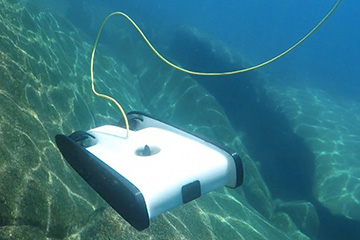 The plethora of
underwater drones
makes one wonder if
the market is trying
to persuade people to
visit the underwater
world without getting
wet! Typical was
the OpenRV Trident
Underwater Drone
that enables 1080p
HD video down to
a depth of 330 feet (100m). Pre-order for $1500.
The plethora of
underwater drones
makes one wonder if
the market is trying
to persuade people to
visit the underwater
world without getting
wet! Typical was
the OpenRV Trident
Underwater Drone
that enables 1080p
HD video down to
a depth of 330 feet (100m). Pre-order for $1500.
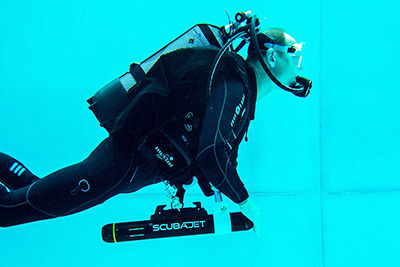 Big diver propulsion vehicles (DPV) were less
obviously on display than before, which might
reflect the problems of transporting big lithium
batteries by air.
Much smaller, the
novel hand-held
Scubajet uses jetpower
instead
of a propeller.
Weighing just 6.6
pounds ((3kg),
the Austrian-made
device generates
44 pounds (20kg)
of thrust up to an hour, yet measures only 16 x 3
inches (42 x 8 cm) with its 200 w/hr 'travel' battery
pack attached. A bigger 400w/hr battery gives a twohour
run-time. It's roughly $1600, much less expensive
than conventional DPVs, yet powerful enough
to push a small surface craft, too. It might be the
perfect accessory for divers daunted by dive sites
with strong currents, and its price and weight make
it a viable accessory choice.
Big diver propulsion vehicles (DPV) were less
obviously on display than before, which might
reflect the problems of transporting big lithium
batteries by air.
Much smaller, the
novel hand-held
Scubajet uses jetpower
instead
of a propeller.
Weighing just 6.6
pounds ((3kg),
the Austrian-made
device generates
44 pounds (20kg)
of thrust up to an hour, yet measures only 16 x 3
inches (42 x 8 cm) with its 200 w/hr 'travel' battery
pack attached. A bigger 400w/hr battery gives a twohour
run-time. It's roughly $1600, much less expensive
than conventional DPVs, yet powerful enough
to push a small surface craft, too. It might be the
perfect accessory for divers daunted by dive sites
with strong currents, and its price and weight make
it a viable accessory choice. 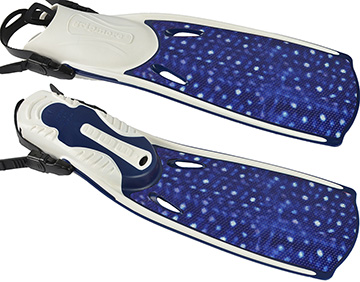 There will always be companies offering
improved-design fins,
and this year a Taiwanese
company showed
GripMore Fins that had
a surface coated with
a surface resembling
fish scales for ostensibly
better grip on the
water. We'll have to
wait to see if the claims
are true or whether it's a "one DEMA product."
There will always be companies offering
improved-design fins,
and this year a Taiwanese
company showed
GripMore Fins that had
a surface coated with
a surface resembling
fish scales for ostensibly
better grip on the
water. We'll have to
wait to see if the claims
are true or whether it's a "one DEMA product."
